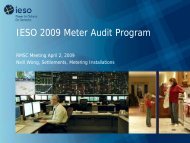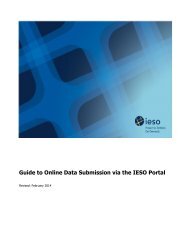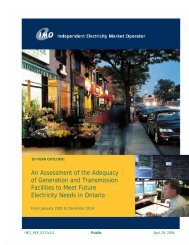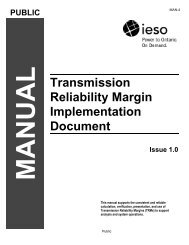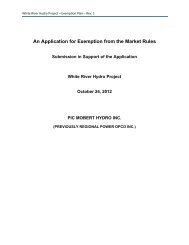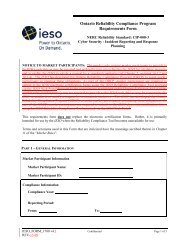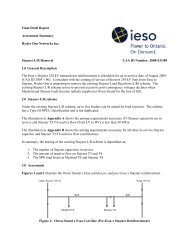Participant Technical Reference Manual - IESO
Participant Technical Reference Manual - IESO
Participant Technical Reference Manual - IESO
You also want an ePaper? Increase the reach of your titles
YUMPU automatically turns print PDFs into web optimized ePapers that Google loves.
<strong>Participant</strong> <strong>Technical</strong> <strong>Reference</strong> <strong>Manual</strong><br />
5. Market Applications<br />
OFFTAKE: A load located outside Ontario. Can also be considered as exports by<br />
<strong>IESO</strong>.<br />
e. Standard time will be used for the date fields. There will be no 23-hour short days and no<br />
25-hour long days. All days will have 24 hours.<br />
f. Blank lines are permitted in the data files, and are ignored. White space is also ignored.<br />
Comma is used as the only data field separator.<br />
g. Comment lines must begin with \\. Comments can also be added at the end of a data line but<br />
it must be preceded by \\. Any text following \\ will be interpreted as comment and will be<br />
ignored. Comments cannot extend past across multiple lines unless each line begins with a<br />
\\.<br />
h. A semi-colon is a record terminator. It will be used as a file header, bid header, and bid<br />
body delimiter. The record terminator is not needed for those records that are comment<br />
lines. A data record must be on a single line. There is no maximum length for a line in an<br />
incoming file so long as a record terminator is specified for record termination. The record<br />
terminator signals the end of the record instead of the end-of-line character.<br />
i. The asterisk character is used to separate multiple bids/offers in a single file. The asterisk<br />
character should be used before and after each bid, which can contain up to 24 hours of<br />
data.<br />
j. All data information in a given template must be included in exactly the same order as<br />
listed. Any additional information or omissions will be considered as an error and will be<br />
rejected.<br />
k. An optional field can have a value or null. If a value has been entered, it will take<br />
precedence over the default value. All fields are mandatory if not specified otherwise.<br />
Optional fields are denoted with field names enclosed within [square brackets] in the<br />
template definitions.<br />
l. All mandatory fields must have values entered. If there is no data for a particular field then<br />
NULL value should be submitted. For example, „value1,,value2‟ contains a NULL value<br />
between value1 and value2.<br />
m. Each tuplet of data, as in the case of (Price, Quantity) or (RampBreakQuantity, RampUp,<br />
RampDown) must be enclosed within parentheses. The entire set of tuplets, i.e. the curve<br />
itself, must be enclosed within curly brackets. For the RTEM, the Price/Quantity data for<br />
an hour or range of hours can have up to 20 tuplets of values with a minimum of two<br />
tuplets. For Energy Ramp Rate tuplets, the maximum is 5 tuplets with a minimum of 1<br />
tuplet. Whatever the number of tuplets is, the data must be included first within parenthesis<br />
and then within curly brackets. As an example „1, {(23.50,0), (23.50,70)}‟ means that the<br />
price curve for 1AM has a two P, Q pairs.<br />
n. A shorthand notation can be used for specifying bid data that does not change across a<br />
contiguous range of hours. The format of the shorthand notation is „x-y‟ for an hour field<br />
and „{(p1, q1), (p20, q20)}‟ for a price curve, where x and y are the start and end hours that<br />
have the same value or the same curve. As an example, the shorthand notation „1-5, 70‟<br />
implies that the value 70 is valid for all hours from 1 AM through 5AM. This shorthand<br />
notation is valid for incoming bids. This data, once received, will be stored on a per hour<br />
basis. This also implies that outgoing data will be given on an hourly basis.<br />
o. When using shorthand notation the hours must be in ascending order only. If there are any<br />
overlaps the records are invalid and will be rejected. As an example<br />
Issue 21.1 – March 15, 2010 - estimated Public 81






